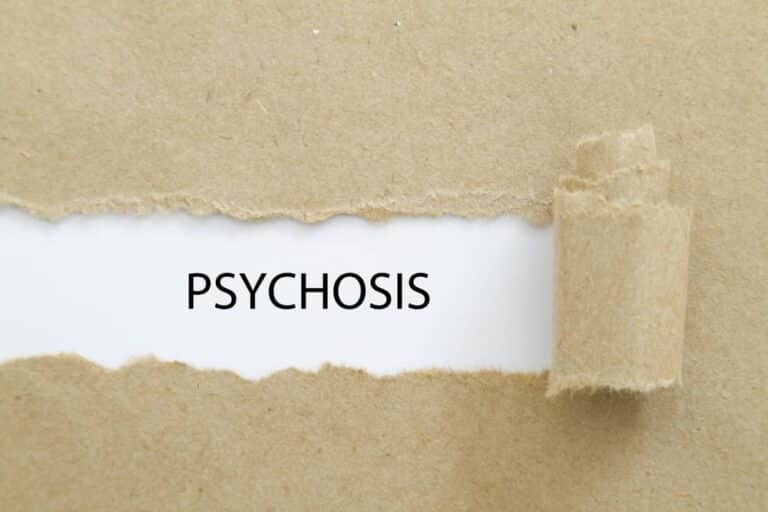Most people have heard of the terms, “postpartum depression” and “anxiety.”
In addition, most new health professionals have been specifically trained on how to properly identify the signs and symptoms of a variety of mental health conditions.
Recently, however, the focus, attention, and research have been on a rarer, more dangerous mental health condition called postpartum psychosis (PPP):
Table of Contents
What is Postpartum Psychosis?
PPP typically arises shortly after the birth of a child, affecting new moms – with or without prior mental health disorders.
According to researchers, PPP first arises as bipolar disorder in approximately 50% of new moms – due to post-delivery hormonal shifts. Following the delivery of a baby, a woman may experience a complete and rapid change in functioning (disorganized behavior, confusion, hallucinations, mania, paranoia, and/or delusions).
When this occurs, it is considered an emergency for both the mother and baby.
Definition
According to the Diagnostic and Statistical Manual of Mental Disorders, 5th ed. (DSM-IV), PPP is considered a severe major depression, or psychotic disorder (or reoccurrence of one), such as schizophrenia. [11, 12]
Researchers suggest that PPP is actually the beginning stages of bipolar disorder, which occurs after the delivery of a child. [13]
In fact, approximately 80% of women with PPP also have bipolar or schizoaffective disorder, while only 12% of them have schizophrenia. [13, 14]
Prevalence
Postpartum psychosis (PPP) typically arises quickly (within 2-4 weeks after delivery) – even 2-3 days afterwards, in some cases. And, it normally affects 1 or 2 births out of 1000. [1-8]
It is less common than postpartum depression (PPD), which affects approximately 12% of new moms and “maternity blues,” which affects approximately 63% of new moms. [9, 10]
Risk Factors
The possible risk factors listed below may, in some cases, place a new mom at higher risk of developing this condition:
Bipolar Disorder
About half of all new moms, who are admitted to the hospital with PPP, have had at least one prior psychiatric episode. In addition, new moms, who have a history of bipolar disorder, may be more susceptible (1-in-4 likelihood) to develop PPP – especially if they experienced severe mood swings, during pregnancy.
Genetics
This condition is extremely common in new moms, who have a family history of postpartum psychosis OR bipolar disorder. For example, a woman with bipolar disorder AND a family history of PPP has a higher risk of developing PPP (1-in-2 moms), following the birth of her child, than a woman without these precursors. However, approximately 50% of new moms with PPP have no family history of this or any other mental health condition.
Sleep Deprivation
Another risk factor for PPP is extreme sleep deprivation. For example, if a woman has a long, complicated labor, and she is unable to rest afterwards, due to non-stop feedings and diaper changes, she may be at-risk of developing this condition.
Postpartum Complications
Pregnancy or delivery complications (for mom and/or baby) can be a risk factor for PPP.
For instance, emotional distress or trauma can cause depression, anxiety, and/or sleep deprivation – triggers for PPP.
In addition, researchers suggest that a heightened immune system response, during or immediately following the delivery of a baby, can trigger PPP.
Poor Support
The absence of a husband or partner, during delivery, and/or little-to-no social support, following childbirth can increase a woman’s risk of developing PPP.
Therefore, it is important for new moms to have strong support systems, following the birth of their babies (during the “postpartum period”) to maintain healthy, rational states of mind, and ease any feelings of depression and/or psychosis.
Age
A woman’s age may or may not be a key risk factor. While some studies suggest that younger moms (under the age of 25) are more likely to develop PPP, following delivery, other scientific studies suggest that older moms (35+) are more likely to develop it.
Sociodemographic Factors
Sociodemographic factors, such as: education, marital status, occupation, and family type appear to have no effect on whether a new mom will develop this condition.
Symptoms
Sudden Mood Swings
Postpartum psychosis (PPP) involves a combination of “highs and lows” (characteristic of bipolar disorder). For instance a new mom may be happy (manic) one minute and then suddenly become anxious and depressed the next.
Mania, Chattiness, Excessive Energy & Low Inhibitions
A new mom with PPP may be manic (happy, excited, energized, and chatty). She may also have low inhibitions.
Mania is considered the “high part” of bipolar disorder and PPP. When a new mom is “high,” she feels great, excited, lively, talkative, and active. She is also more likely to take risks and act “out of character.”
Anxiety, Depression & Irritability
A new mom with PPP may experience anxiety, depression, and irritability during her “low points.” She may feel “teary” and “on the edge.” This new mom may also feel that she is unable to fully care for her new baby.
Sleep Issues
It is very common for women with PPP to experience sleep issues. Sometimes the sleep issues are caused by the PPP, and sometimes the PPP causes the sleep issues.
And, although “new baby sleep issues” are expected (to some degree), women without PPP are able to get some “shut eye” while their babies sleep, while women with PPP often can’t sleep or don’t want to sleep at all.
Paranoia, Confusion, Disorientation & Delusions
Paranoia, confusion, disorientation, and delusions are key symptoms that differentiate postpartum psychosis (PPP) from postpartum depression (PPD). A new mom with PPP experiences an altered reality that causes her to interpret actions and events differently and more irrationally, than new moms with PPD.
Baby-Related Obsessions
One symptom that new moms with PPP often experience is baby-related obsessions.
These women have an irrational fear that they will hurt their babies in some way. They also fear that their babies will die – due to something they did or didn’t do. And although the fear of hurting their fragile babies is something that many new moms naturally worry about, most do not obsess about it.
***It is important to note that the classic PPP mom is withdrawn, confused, catatonic, blathery, and/or agitated. Moreover, she usually has problems sleeping, is secretively jealous of her baby, often feels persecuted, and/or regularly experiences visual or auditory hallucinations. [4,5,6]
The good news is only 9% of women with PPP have thoughts of harming their babies.7 However, the suicide rate for new moms with PPP increases 70%, during the first year of their children’s lives.[24]
Diagnosis
PPP is usually discovered by a partner, family member, or friend. Although, in some cases, it is discovered by a healthcare professional, during a routine postpartum visit or phone call.
The Edinburgh Postnatal Depression Scale (EPDS) [16] and the Mood Disorder Questionnaire (MDQ) [17] are useful tools that screen for depression and mania/hypomania.
The EPDS involves a series of questions that allows a new mom to self-rate her depression symptoms (i.e. persistent low mood).
The MDQ evaluates past and current mood fluctuations, excessive bouts of energy, racing thoughts, and fast speech. [25]
Treatment
The first step in the treatment process is to educate the new mom and her family on the condition. This typically occurs once an official diagnosis has been made. The purpose of this first step is to encourage the patient’s commitment to the treatment process and explain the consequences of not treating the condition. [18]
Since PPP is a form of bipolar disorder, doctors typically prescribe lithium, anti-seizure drugs (valproate or carbamazepine), and/or anti-psychotic medications (olanzapine, quetiapine, ziprasidone, or aripiprazole) to patients.
Psychotherapy is also used to treat PPP. In fact, cognitive behavioral therapy (CBT), family therapy (FT), and interpersonal psychotherapy (IPT) are often used in conjunction with medications. [19]
Electroconvulsant therapy (ECT) is also used to provide rapid symptom relief in new moms who have been admitted to hospital with acute and severe psychosis. The good news is that ECT has come a long way, since the 60s and 70s. It now involves anesthetizing the individual during the procedure to control severe muscle spasms and pain.
After ECT treatment, the results can be dramatic. This PPP treatment is ideal for:
- Women who are unable to be stabilized through standard medications
- Women who have experienced terrible drug side-effects
- Women who have reported having suicidal thoughts, and thus, cannot wait for the drug(s) to take effect weeks later. [20, 23]
Lastly, estrogen supplementation has garnered mixed results in the treatment of PPP.
Outlook
It is important to understand that if you have had PPP once, you are more likely to have it again with future children.
The good news is that by knowing the signs and symptoms of this condition, you can better plan for it. In other words, you can work with your OBGYN and a psychologist or psychiatrist to develop a treatment plan after the delivery of your baby.
This plan may include: medications, coping techniques, lifestyle changes, and/or psychotherapy.
Therefore, it is essential that you let your doctor know how you are feeling and what you are thinking during the pregnancy, during the delivery, and after the birth of your child.
It is also important that you keep a lookout for any PPP symptoms.
Surround yourself with positive, supportive friends and family during the pregnancy and after the delivery. You will need their support as you adjust to your new baby.
Keep in mind, there is a possibility you may be unable to breastfeed if you are placed on medications, so discuss this factor with your doctor – if you plan to breastfeed.
In severe cases you may need to be briefly admitted into a clinic for treatment.
Just remember: being prepared for PPP will ease your nerves and minimize the effects of it.
You don’t have to allow PPP to control you – you can control it instead!
References
- Kendell, R., Chalmers, J., & Platz, C. (1987). Epidemiology of puerperal psychoses. Br J Psychiatry, 150, 662.
- Kumar, R. (1994). Postnatal mental illness: A transcultural perspective. Social Psychiatry Epidemiology, 29, 250.
- Okano, T., Nomura, J., Kumar, R., et al. (1998). An epidemiological and clinical investigation of postpartum psychiatric illness in Japanese mothers. Journal Affective Disorder, 48, 233.
- Dean, C., & Kendell, R. E. (1981). The symptomatology of puerperal illnesses. Br J Psychiatry, 139, 128.
- Meltzer, E. S., & Kumar, R. (1985). Puerperal mental illness, clinical features, and classification: A study of 142 mother-and-baby admissions. Br J Psychiatry, 147, 647.
- Klompenhouwer, J. (1991). Classification of postpartum psychosis: A study of 250 mother and baby admissions in the Netherlands. Acta Psychiatr Scand, 84, 255.
- Kumar, R., Marks, M., Platz, C., & Yoshida, K. (1995). Clinical survey of a psychiatric mother and baby unit: Characteristics of 100 consecutive admissions. J Affective Disorder, 33, 11.
- Brockington, I., Cernik, A., Schofield, E., et al. (1981). Puerperal psychosis, phenomena and diagnosis. Arch Gen Psychiatry, 38, 829.
- O’Hara, M. W., & Swain, A. M. (1996). Rates and risks of post-partum depression—A meta-analysis. Int Rev Psychiatry, 8, 37.
- O’Hara, M., Schlechte, J., & Lewis, D., et al. (1991). Controlled prospective study of postpartum mood disorders: Psychological, environmental, and hormonal variables. J Abnormal Psychology, 100, 63.
- American Psychiatric Association. (1994). Diagnostic and statistical manual for mental disorders (DSM-IV). Washington, DC: American Psychiatric Press.
- American Psychiatric Association. (2000). Diagnostic and statistical manual for mental disorders (DSM-IV). Washington, DC: American Psychiatric Press.
- Yonkers, K., Wisner, K., Stowe, Z., et al. (2004). Management of bipolar disorder during pregnancy and the post-partum period. Am J Psychiatry, 161, 608.
- Brockington, I. F. (1996). Puerperal psychosis: Motherhood and mental health. New York: Oxford University Press.
- Wisner, K., Peindl, K., & Hanusa, B. (1995). Psychiatric episodes in women with young children. Journal Affective Disorder, 34, 1.
- Cox, J. L. (1983). Postnatal depression: A comparison of African and Scottish women. Social Psychiatry, 18, 25.
- Hirschfeld, R., Holzer, C., Calabrese, J., et al. (2003). Validity of the mood disorder questionnaire: A general population study. Am J Psychiatry, 160, 178.
- Spinelli, M. (2004). Maternal infanticide associated with mental illness prevention and the promise of saved lives. Am J Psychiatry, 161, 1548.
- Zlotnick, C., Johnson, S. L., Miller, I. W. (2001). Postpartum depression in women receiving public assistance: Pilot study of an interpersonal therapy-oriented group intervention. Am J Psychiatry,158, 638.
- Reed, P., Sermin, N., & Appleby, L. (1999). A comparison of clinical response to electroconvulsive therapy in puerperal and non-puerperal psychoses. J Affective Disorder, 54, 255.
- De Macedo-Soares, M.B., Mareno, R.A., & Rigonatti, S.P. (2005). Efficacy of electroconvulsive therapy in treatment-resistant bipolar disorder: A case series. J ECT, 21, 31.
- Ciapparelli, A., Dell’Osso, L., & Tundo, A. (2001). Electroconvulsive therapy in medication nonresponsive patients with mixed mania and bipolar depression. J Clin Psychiatry, 62, 552.
- Volpe, F. M., & Travares, A. (2004). Manic patients receiving ECT in a Brazilian sample. Journal Affective Disorder, 79, 201.
- CEMD. (2001). Confidential inquiries into maternal deaths: Why mothers die, 1997–99. London: Royal College of Obstetricians and Gynecologists.
- Cohen, L. S. (1997). Massachusetts general hospital: Handbook of general hospital psychiatry. St. Louis: Mosby Yearbook.







